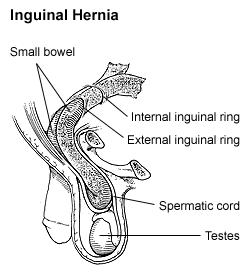Superficial inguinal ring
| Superficial inguinal ring | |
|---|---|
 Front of abdomen, showing surface markings for arteries and inguinal canal (superficial inguinal ring labeled as subcutaneous inguinal ring at lower left) | |
 The superficial inguinal ring. | |
| Details | |
| Identifiers | |
| Latin | Anulus inguinalis superficialis |
| Dorlands /Elsevier | a_50/12143741 |
| TA | A04.5.01.013 |
| FMA | 19926 |
The superficial inguinal ring (subcutaneous inguinal ring or external inguinal ring) is an anatomical structure in the anterior wall of the mammalian abdomen. It is a triangular opening that forms the exit of the inguinal canal, which houses the ilioinguinal nerve, the genital branch of the genitofemoral nerve, and the spermatic cord (in men) or the round ligament (in women). At the other end of the canal, the deep inguinal ring forms the entrance.[1]
It is found within the aponeurosis of the external oblique, immediately above the pubic crest, 1 centimeter above and superolateral to the pubic tubercle. It has the following boundaries—medial crura by pubic crest, lateral crura by pubic tubercle and inferiorly by inguinal ligament. [2]
Clinical significance
The superficial ring is palpable[3] under normal conditions. It becomes dilated in a condition called athletic pubalgia. Abdominal contents may protrude through the ring in inguinal hernia.
Gallery

 Superficial inguinal ring
Superficial inguinal ring- Anterior abdominal wall.Intermediate dissection.Anterior view
See also
References
This article incorporates text in the public domain from the 20th edition of Gray's Anatomy (1918)
External links
- Anatomy photo:35:09-0101 at the SUNY Downstate Medical Center - "Anterior Abdominal Wall: Borders of the Superficial Inguinal Ring"
- Anatomy figure: 36:01-13 at Human Anatomy Online, SUNY Downstate Medical Center - "The inguinal canal and derivation of the layers of the spermatic cord."